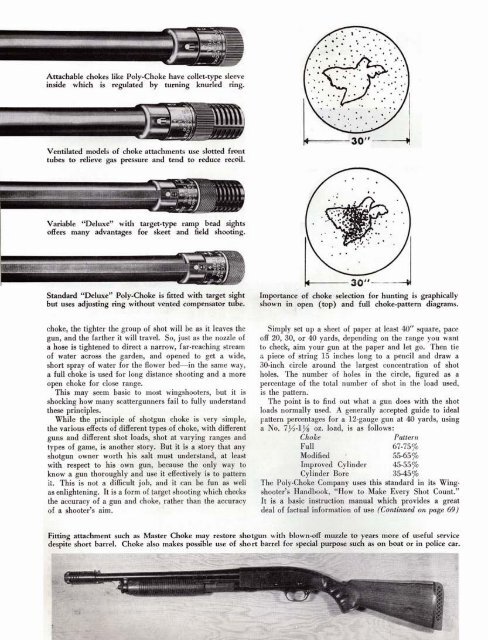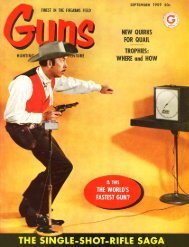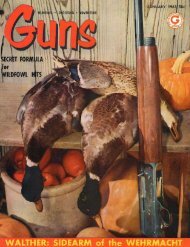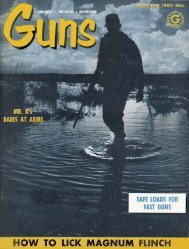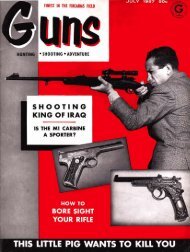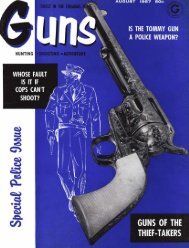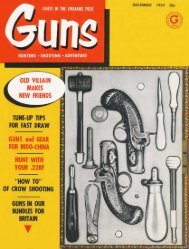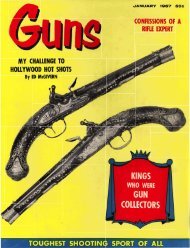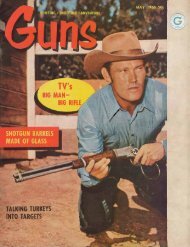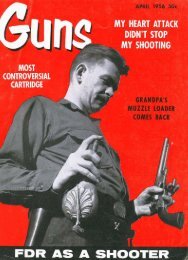You also want an ePaper? Increase the reach of your titles
YUMPU automatically turns print PDFs into web optimized ePapers that Google loves.
Attachable chokes like Poly-Choke have collet-type sleeve<br />
inside which is regulated by turning knurled ring.<br />
Ventilated models of choke attachments use slotted front<br />
tubes to relieve gas pressure and tend to reduce recoil.<br />
Variable "Deluxe" with target-type ramp bead sights<br />
offers many advantages for skeet and field shooting.<br />
Standard "Deluxe" Poly-Choke is fitted with target sight<br />
but uses adjusting ring without vented compensator tube.<br />
choke, the tighter the group of shot will<br />
gun. ., , and thefarther itwilltravel. So. , . iust as the nozzle of<br />
a hose is tightened to direct a narrow, far-reaching stream<br />
of water across the garden, and opened to get a wide,<br />
short spray of water for the flower bed-in the same way,<br />
a full choke is used for long distance shooting and a more<br />
open choke for close range.<br />
This may seem basic to most wingshooters, but it is<br />
shocking how many scattergunners fail to fully understand<br />
these principles.<br />
While the principle of shotgun choke is very simple,<br />
the various effects of different types of choke, with different<br />
guns and different shot loads, shot at varying ranges and<br />
types of game, is another story. But it is a story that any<br />
shotgun owner worth his salt must understand, at least<br />
with respect to his own gun, because the only way to<br />
know a gun thoroughly and use it effectively is to pattern<br />
it. This is not a difficult job, and it can be fun as well<br />
as enlightening. It is a form of target shooting which checks<br />
the accuracy of a gun and choke, rather than the accuracy<br />
of a shooter's aim.<br />
x,<br />
Importance of choke selection for hunting is graphically<br />
shown in open (top) and full choke-pattern diagrams.<br />
Simply set up a sheet of paper at least 40" square, pace<br />
off 20, 30, or 40 yards, depending on the range you want<br />
to check, aim your gun at the paper and let go. Then tie<br />
a piece of string 15 inches long to a pencil and draw a<br />
30-inch circle around the largest concentration of shot<br />
holes. The number of holes in the circle, figured as a<br />
percentage of the total number of shot in the load used,<br />
is the pattern.<br />
The point is to find out what a gun does with the shot<br />
loads normally used. A generally accepted guide to ideal<br />
pattern percentages for a 12-gauge gun at 40 yards, using<br />
a No. 7%-1% oz. load, is as follows:<br />
Choke Pattern<br />
Full 67-75%<br />
Modified 55-65%<br />
Improved Cylinder 45-55%<br />
Cylinder Bore 35-45%<br />
The Poly-Choke Company uses this standard in its Wing-<br />
shooter's Handbook, "How to Make Every Shot Count."<br />
It is a basic instruction manual which provides a great<br />
deal of factual information of use (Continued on page 69)<br />
Fitting attachment such as Master Choke may restore shotgun with blown-off muzzle to years more of useful service<br />
despite short barrel. Choke also makes possible use of short barrel for special purpose such as on boat or in police car.


